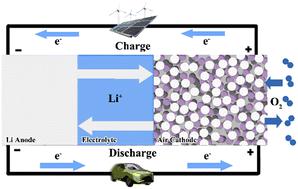当前位置:
X-MOL 学术
›
Chem. Soc. Rev.
›
论文详情
Our official English website, www.x-mol.net, welcomes your
feedback! (Note: you will need to create a separate account there.)
Evolving aprotic Li–air batteries
Chemical Society Reviews ( IF 40.4 ) Pub Date : 2022-09-01 , DOI: 10.1039/d2cs00003b Zhenzhen Wu 1 , Yuhui Tian 1 , Hao Chen 1 , Liguang Wang 2, 3 , Shangshu Qian 1 , Tianpin Wu 2 , Shanqing Zhang 1 , Jun Lu 2
Chemical Society Reviews ( IF 40.4 ) Pub Date : 2022-09-01 , DOI: 10.1039/d2cs00003b Zhenzhen Wu 1 , Yuhui Tian 1 , Hao Chen 1 , Liguang Wang 2, 3 , Shangshu Qian 1 , Tianpin Wu 2 , Shanqing Zhang 1 , Jun Lu 2
Affiliation

|
Lithium–air batteries (LABs) have attracted tremendous attention since the proposal of the LAB concept in 1996 because LABs have a super high theoretical/practical specific energy and an infinite supply of redox-active materials, and are environment-friendly. However, due to the lack of critical electrode materials and a thorough understanding of the chemistry of LABs, the development of LABs entered a germination period before 2010, when LABs research mainly focused on the development of air cathodes and carbonate-based electrolytes. In the growing period, i.e., from 2010 to the present, the investigation focused more on systematic electrode design, fabrication, and modification, as well as the comprehensive selection of electrolyte components. Nevertheless, over the past 25 years, the development of LABs has been full of retrospective steps and breakthroughs. In this review, the evolution of LABs is illustrated along with the constantly emerging design, fabrication, modification, and optimization strategies. At the end, perspectives and strategies are put forward for the development of future LABs and even other metal–air batteries.
中文翻译:

不断发展的非质子锂空气电池
自 1996 年 LAB 概念提出以来,锂空气电池 (LABs) 因其具有超高的理论/实践比能量和无限供应的氧化还原活性材料以及对环境友好而引起了极大的关注。然而,由于缺乏关键的电极材料和对 LAB 化学的透彻了解,LAB 的发展在 2010 年之前进入了萌芽期,当时 LAB 的研究主要集中在空气阴极和碳酸盐基电解质的开发上。在生长期,即,从2010年至今,研究更多集中在系统的电极设计、制造和修改,以及电解质成分的综合选择上。然而,25年来,实验室的发展充满了回溯和突破。在这篇评论中,LAB 的演变与不断涌现的设计、制造、修改和优化策略一起被说明。最后,对未来实验室乃至其他金属空气电池的发展提出了展望和策略。
更新日期:2022-09-01
中文翻译:

不断发展的非质子锂空气电池
自 1996 年 LAB 概念提出以来,锂空气电池 (LABs) 因其具有超高的理论/实践比能量和无限供应的氧化还原活性材料以及对环境友好而引起了极大的关注。然而,由于缺乏关键的电极材料和对 LAB 化学的透彻了解,LAB 的发展在 2010 年之前进入了萌芽期,当时 LAB 的研究主要集中在空气阴极和碳酸盐基电解质的开发上。在生长期,即,从2010年至今,研究更多集中在系统的电极设计、制造和修改,以及电解质成分的综合选择上。然而,25年来,实验室的发展充满了回溯和突破。在这篇评论中,LAB 的演变与不断涌现的设计、制造、修改和优化策略一起被说明。最后,对未来实验室乃至其他金属空气电池的发展提出了展望和策略。











































 京公网安备 11010802027423号
京公网安备 11010802027423号